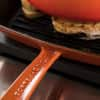Explaining "Clad" Pans
What are "clad" pans, and do you recommend them?
Cladding is a common method for fabricating cookware in which a layer of very conductive metal, like copper or aluminum, is sandwiched between layers of a nonreactive and durable but less conductive metal like stainless steel. “Fully clad” pans feature this layered construction all the way up to the rim. This combination of a heat-efficient aluminum (or copper) core with a stainless steel coating yields pans that heat up relatively quickly, retain heat evenly, and don’t react with acidic food like tomato sauce or vinegar. Pans that are not clad may be constructed of a single material, or, to mimic the effect of cladding, they may have a thick aluminum disk either attached to their base or built into the bottom of the pan. This disk-style cookware is sometimes advertised as an “aluminum encapsulated base” or “tri-ply base,” not to be confused with fully clad pans advertised as “tri-ply” or three-layer. Disk-style cookware is generally less expensive than clad but is apt to scorch the food nearest the edges of the pan because the unclad sides may heat unevenly.
Our favorite fully clad skillet is the All-Clad stainless 12-inch fry pan, for $135. Our favorite fully clad large saucepans are the All-Clad stainless 4-quart saucepan, for $194.99, and the Cuisinart MultiClad Unlimited 4-quart saucepan, for $69.99.
THE BOTTOM LINE: Clad cookware, which combines the conductivity of aluminum or copper with durable, nonreactive stainless steel, is more desirable than disk-style or single-ply cookware, but it is also more expensive. If you’re pinching pennies, go for full cladding on just the one or two pans you use most.
Pans with aluminum encapsulated just in their bases provide good heat retention on the bottom but may scorch food around the edges.
Fully clad pans offer even heat from top to bottom.


